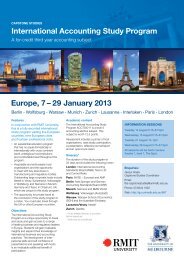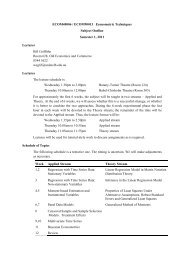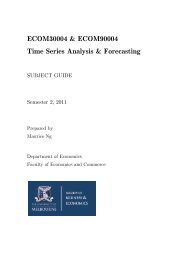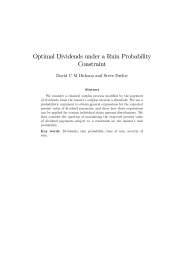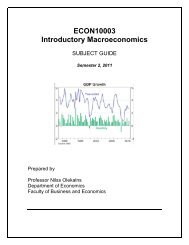A Model of Optimal Corporate Bailouts - Faculty of Business and ...
A Model of Optimal Corporate Bailouts - Faculty of Business and ...
A Model of Optimal Corporate Bailouts - Faculty of Business and ...
Create successful ePaper yourself
Turn your PDF publications into a flip-book with our unique Google optimized e-Paper software.
<strong>and</strong> the firm pay<strong>of</strong>fs are 2R −Π| F G=FIRE( e ∗ ) = T1− I1 1 .4·cSubcase 2: Bailed-Out Firm Restarts with Same Manager. If instead the manager isretained, then she expects to receive positive continuation pay<strong>of</strong>fs in the amount m ∗( 2 g∗ ) =R 2 / (8·c), while the firm continues to expect zero continuation pay<strong>of</strong>fs. Given her wage, themanager maximizesM ≡ e 1·w 1 − c·e2 12 + (1 − e 1)·m ∗ ( 2 g∗ ) = e 1·w 1 − c·e2 12 + (1 − e 1)· R28·c ,which yields an effort level (as a function <strong>of</strong> wages) <strong>of</strong> e ∗( w 1 1 ) = w 1 /c − R 2 /(8·c 2 ). The secondterm is the manager’s option to continue even when the firm is bailed out—i.e., the manager’smoral hazard. Therefore, the firm chooses w 1 to maximize its first-period pr<strong>of</strong>its, Π| F G=RETAIN = e ∗ ( w w11 1 )·(R − w 1 − T 1 ) + (1 − e ∗ 1 )·π∗ 2 g ∗ , T ∗ =2} {{ } c − R2· R − w8·c 2 1 − T 1 ,=0where T 1 is the government tax in the first period. The firm’s pr<strong>of</strong>it maximizing wage <strong>of</strong>fer isw ∗ = R − T1 1 /2 + R 2 /(16·c). Substituting this wage into the manager’s optimal effort levelyieldse ∗ 1 = R − T 12·c−R216·c 2 .Note that, similar to the case <strong>of</strong> non-intervention, first-period effort is lower when the incumbentmanager is retained after a bailout. When the manager expects positive rents even in thebailout state, she rationally spends less in effort costs to avoid that state. Firm pr<strong>of</strong>its areΠ| F G=RETAIN( e ∗ 1 ) = 1 c ·R − T12− R216·c 2− I 1 .Comparing the two subcases leads to the following lemma:Lemma 2 As long as the incumbent <strong>and</strong> replacement are equally productive, the optimal bailoutpolicy replaces the manager whenever the firm receives a bailout.Similar to Lemma 1 in the non-intervention case, Lemma 2 states that retaining the manager isnever optimal. A credible threat to fire the manager upon a bailout improves her first-periodincentives without affecting second period effort. As long as the replacement manager is aspr<strong>of</strong>icient as her predecessor, this results in a net gain.18



